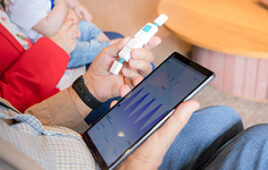.jpg)
Science has yet to unravel a complete understanding of the brain and all its intricate workings. It’s not for lack of effort.
Over many decades, multiple research studies have sought to understand the dizzying “talk,” or interconnectivity, between thousands of microscopic entities in the brain, in particular, neurons. The goal: to one day arrive at a complete brain “mapping” — a feat that could unlock tremendous therapeutic potential.
Researchers at the University of Southern California Viterbi School of Engineering have developed thin, flexible polymer-based materials for use in microelectrode arrays that record activity more deeply in the brain and with more specific placement than ever before. What’s more is that each microelectrode array is made up of eight “tines,” each with eight microelectrodes which can record from a total 64 subregions of the brain at once.
In addition, the polymer-based material, called Parylene C, is less invasive and damaging to surrounding cells and tissue than previous microelectrode arrays comprised of silicon or microwires. However, the long and thin probes can easily buckle upon insertion, making it necessary to add a self-dissolving brace made up of polyethylene glycol (PEG) that shortens the array and prevents it from bending.
Professor Ellis Meng of the USC Viterbi Department of Biomedical Engineering and Michelson Center for Convergent Bioscience said that the performance of the new polymer-based material is on par with microwires in terms of recording fidelity and sensitivity. “The information that we can get out is equivalent, but the damage is much less,” Meng said. “Polymers are gentler on the brain, and because of that, these devices get recordings of neuronal communication over long periods of time.”
As with any prosthetic implant, caution must be exercised in terms of the body’s natural immune response to a foreign element. In addition to inflammation, previous microelectrode brain implants made of silicon or microwire have caused neuronal death and glial scarring, which is damage to connective tissue in the nervous system. However, Parylene C is biocompatible and can be microfabricated in extremely thin form that molds well to specific sub-regions of the brain, allowing for exploration with minimal tissue displacement and cell damage.
So far, these arrays have been used to record electrophysiological responses of individual neurons within the hippocampus, a subregion of the brain responsible for memory formation. If injured, the hippocampus may be compromised, resulting in a patient’s inability to form new memories. Meng said that the polymer-based material can conform to a specific location in the hippocampus and “listen in on a conversation” between neurons and because there are many such “eavesdroppers” (the microelectrodes), much more information about neural interconnectivity can be gleaned.
“I can pick where I want my electrodes to be, so I can match up to the anatomy of the brain,” Meng said. “Along the length of a tine, I can put a group of electrodes here and a group of electrodes there, so if we plant to a certain depth, it’s going to be near the neurons I want to record from.”
Future research will determine the recording lifetime of polymer-based arrays and their long-term “signal-to-noise” (SNR) stability. Also, the team plans to create devices with even higher density, including a double-sided microelectrode array with 64 electrodes per tine instead of eight — making for a total of around 4,000 electrodes placed in the brain at once.




